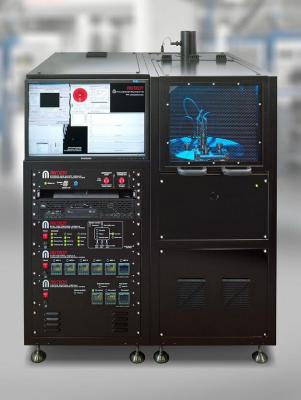Graphenea to take part in an ESPRC project on 2D materials for medical applications
 Graphenea recently announced its participation in a new project funded by EPSRC (the UK's main agency for funding research in engineering and the physical sciences). The project 2D Materials for Next Generation Healthcare Technologies (2D-Health) started on October 1 st and will utilize £5.2 million of funding over the next 5 years.
Graphenea recently announced its participation in a new project funded by EPSRC (the UK's main agency for funding research in engineering and the physical sciences). The project 2D Materials for Next Generation Healthcare Technologies (2D-Health) started on October 1 st and will utilize £5.2 million of funding over the next 5 years.
The project will aim to explore how 2D materials can assist in tackling major health challenges, such as cancer, diabetes and dementia. 2D-Health is one of four major research grants awarded as part of the EPSRC Healthcare Technologies scheme, totaling £17.7 million, that will develop new technologies to address the health issues of an aging UK population.
Graphenea updates on progress of plans for mass production of high quality graphene
 The Spain-based Graphenea recently announced that preparations are on track for mass production of 200 mm (8) diameter high quality graphene on Si/SiO2 wafers. Last week cleanroom components arrived to be assembled in a new production space at the company's location in San Sebastian. Production of 200 mm graphene on a new chemical vapor deposition system is expected to be up and running at the beginning of 2017.
The Spain-based Graphenea recently announced that preparations are on track for mass production of 200 mm (8) diameter high quality graphene on Si/SiO2 wafers. Last week cleanroom components arrived to be assembled in a new production space at the company's location in San Sebastian. Production of 200 mm graphene on a new chemical vapor deposition system is expected to be up and running at the beginning of 2017.
The investment in the new lab will increase the company’s production capacity and quality of graphene wafers. The new addition will represent a tenfold expansion of Graphenea's production space, where it currently routinely manufactures high quality graphene with a diameter of 100 mm (4). The production capacity will increase 20-fold with the addition of the new line, to produce 4, 6, and 8 wafers as standard.
Experts roundup: on Graphene Oxide for composites
Last month we launched a new feature - Experts Roundup. In this feature we ask graphene professionals to answer a short graphene related question. Last month's question was "will CVD ever be a viable commercial way to produce graphene?" and we got great response to that. Hopefully this month feature will be just as good.
In the growing field of graphene-enhanced composites, especially plastics, how does graphene oxide fit in? Does it have any significant advantages over graphene?
Ian Fuller, VP business development & engineering, Angstron Materials : I would classify graphene oxide as a functionalized graphene nanomaterial. Functionalization, in general, allows for tailored nanomaterials for applications such as polymer nanocomposites. The oxygen-based groups on the surface of graphene oxide often promote coupling between the polymer and the nanomaterial leading to enhanced properties such as strength and quality of dispersion (however, electrical and thermal conductivity are often reduced). Similarly, other functional groups can be added to the surface of a graphene platelet to customize it for a range of applications and polymers.
Graphenea updates on its CVD graphene status
Last month we asked several graphene experts about their thoughts on the commercial potential of CVD as a graphene production process. This interesting discussion led to my talk with Jesus de la Fuente, Graphenea's Founder & CEO.

Graphenea is one of the world's leaders in CVD graphene, and Jesus kindly agreed to update us on his thoughts on CVD and the recent advances made at Graphenea.
Graphenea increases capacity with AIXTRON BM Pro
Graphenea recently ordered a BM Pro system from AIXTRON, a worldwide leading provider of deposition equipment to the semiconductor industry.

AIXTRON’s BM Pro system, now in its 3rd generation, has been specifically optimized for high quality graphene deposition with Graphenea’s tool having the highest throughput to date. Graphenea placed the order for the 8-inch configuration deposition system during the first quarter of 2016. The tool is scheduled for delivery later this year which will be followed by the installation and commissioning of the system by AIXTRON’s European support team.
Graphenea announces increased capacity and reduced prices
 Spain-based Graphenea announced reduced prices on products and increased production capacity in 2016. Improving the material quality of staple products remains a key strategy for Graphenea, alongside limited strategic expansion of the product offering.
Spain-based Graphenea announced reduced prices on products and increased production capacity in 2016. Improving the material quality of staple products remains a key strategy for Graphenea, alongside limited strategic expansion of the product offering.
Graphenea states that improvements in process productivity will lead to reduced graphene prices this year. In particular, the price of CVD graphene film will decrease in all categories by 23% on average this year, as the company intends to provide a very competitive offer on all substrates and sizes to support their customers’ research. Prices of graphene on custom substrates will decrease by 27%, making it easier for researchers to work on their own substrate. The price of graphene oxide (GO) for research will decrease by 33% on average.
European researchers reach graphene production breakthrough, under project GRAFOL
Researchers involved in the 10.6 million Euro European research project called GRAFOL have reportedly demonstrated a cost-effective roll-to-roll production tool capable of making large sheets of graphene on an industrial scale. The tool operates at atmospheric pressure and at reduced operating temperature, and is proclaimed by the researchers "the best route to low-cost manufacture".

Graphene-enhanced perovskite PV
The project team also believes that graphene could be used as a substitute for transparent indium tin oxide (ITO) electrodes used in organic LEDs (OLEDs), enabling flexible designs while helping reduce dependency on ITO. In addition, the team showed that it is possible to adapt the CVD method to grow graphene on 300 mm-diameter silicon wafers the standard size currently used in the semiconductor industry. That suggests the potential to integrate graphene in silicon photonics platforms, as well as flexible thin-film solar cells with transparent electrodes (like perovskite PVs, for example).
We discuss graphene as transparent OLED electrodes with the Fraunhofer FEP
A few days ago we reported that the Fraunhofer Institute FEP will demonstrate an OLED device with a graphene-based electrode, as part of project GLADIATOR. The researchers hope that the graphene will enable devices that are highly flexible and stable. The CVD-produced monolayer graphene was produced by Graphenea, and the project that will run until April 2017 aims to produce larger demonstrators.

We had the good chance of talking to Beatrice Beyer, the project's coordinator at the Fraunhofer Institute, and she was kind enough to answer a few questions we had regarding the project and the technology they develop.
Q: Beatrice, thanks for your time. Can you explain to us how the graphene compares to ITO as an OLED electrode?
For the time being, the optoelectronic performance of graphene as a transparent electrode is still not as good as for the mature 'industry standard' ITO, but the performance and production technologies are continuously improving and we are optimistic that soon graphene based devices will reliably compete with ITO based on performance.
The Fraunhofer Institute to demonstrate a graphene transparent electrode for OLEDs
As part of project GLADIATOR, The Fraunhofer Institute FEP will show an innovative organic light emitting diodes (OLEDs) with a graphene-based electrode at Plastic Electronics 2015. The fabricated OLED on transparent graphene electrodes has been realized on a small area, and the target of the next one and a half years of the project is to successfully achieve large area OLEDs.

With graphene as an electrode, the researchers at the Fraunhofer FEP hope for flexible devices with higher stability. The electrode contains CVD-produced monolayer graphene of high quality, supplied by Graphenea, in order to compete with the reference material ITO (which graphene, in this case, replaces), the transparency and conductivity of graphene must be very high. Therefore, not only the process of electrode manufacturing is being optimized, but also different ways of doping graphene to improve its properties are being examined.
High temperature reduction process increases thermal conductivity of rGO
A collaborative research performed by scientists from UC Riverside, Moldova State University, and Graphenea demonstrates that a method of reducing graphene oxide to graphene via a high-temperature treatment that increases thermal conductivity along the film direction, while decreasing it across the film. The scientists stress the potential of using this method for thermal management applications, such as fillers in thermal interface materials or flexible heat spreaders for cooling electronics.

The research shows that thermal conductivity of GO can be majorly increased (nearly 30 times) by bringing GO to a high temperature during a reduction process. It appears that GO, when heated to 1000°C, turns to reduced GO (rGO) that has a high thermal conductivity along the sheet plane. In contrast, thermal conductivity perpendicular to the sheet shows an opposite trend, decreasing with thermal treatment.
Pagination
- Previous page
- Page 6
- Next page
